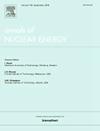Effect of bubble entrainment on thermal–hydraulic performance of LBE-cooled wire-wrapped rod bundles
IF 1.9
3区 工程技术
Q1 NUCLEAR SCIENCE & TECHNOLOGY
引用次数: 0
Abstract
The lead–bismuth fast reactor (LFR) is at risk of steam generator heat transfer tube rupture (SGTR), which could result in the entry of liquid lead–bismuth with bubble entrainment into the core, potentially impacting the thermal–hydraulic performance of the wire-wrapped rod bundles. In this study, a three-dimensional numerical model of the flow domain of 7-pin wire-wrapped rod bundles is established, in conjunction with the population balance model and the mixture two-phase flow model. Numerical simulation is conducted under cases of both liquid lead–bismuth single-phase flow and two-phase bubbly flow. The influence of inlet velocity, inlet void fraction, and inlet average bubble diameter on the thermal–hydraulic performance of wire-wrapped rod bundles is investigated. The study reveals that bubble entrainment leads to chaotic flow patterns and intensifies vortex phenomena. Bubbles tend to coalesce rather than rupture in the flow domain, and the average bubble diameter shows a positive correlation with the inlet void fraction. Furthermore, an increased inlet void fraction leads to higher rod wall temperature, overall Nusselt number, and friction factor. In contrast, an increase in the inlet average bubble diameter shows a negative correlation with the friction factor and overall Nusselt number.
求助全文
约1分钟内获得全文
求助全文
来源期刊

Annals of Nuclear Energy
工程技术-核科学技术
CiteScore
4.30
自引率
21.10%
发文量
632
审稿时长
7.3 months
期刊介绍:
Annals of Nuclear Energy provides an international medium for the communication of original research, ideas and developments in all areas of the field of nuclear energy science and technology. Its scope embraces nuclear fuel reserves, fuel cycles and cost, materials, processing, system and component technology (fission only), design and optimization, direct conversion of nuclear energy sources, environmental control, reactor physics, heat transfer and fluid dynamics, structural analysis, fuel management, future developments, nuclear fuel and safety, nuclear aerosol, neutron physics, computer technology (both software and hardware), risk assessment, radioactive waste disposal and reactor thermal hydraulics. Papers submitted to Annals need to demonstrate a clear link to nuclear power generation/nuclear engineering. Papers which deal with pure nuclear physics, pure health physics, imaging, or attenuation and shielding properties of concretes and various geological materials are not within the scope of the journal. Also, papers that deal with policy or economics are not within the scope of the journal.
 求助内容:
求助内容: 应助结果提醒方式:
应助结果提醒方式:


